The global dolomite market size is calculated at USD 2.45 billion in 2025 and is forecasted to reach around USD 4.43 billion by 2034, accelerating at a CAGR of 6.77% from 2025 to 2034. The Asia Pacific dolomite market size surpassed USD 910 million in 2025 and is expanding at a CAGR of 6.92% during the forecast period. The market sizing and forecasts are revenue-based (USD Million/Billion), with 2024 as the base year.
The global dolomite market size was estimated at USD 2.30 billion in 2024 and is predicted to increase from USD 2.45 billion in 2025 to approximately USD 4.43 billion by 2034, expanding at a CAGR of 6.77% from 2025 to 2034. Dolomite's hardness and acid resistance make it a valuable building material, especially for making concrete and asphalt.
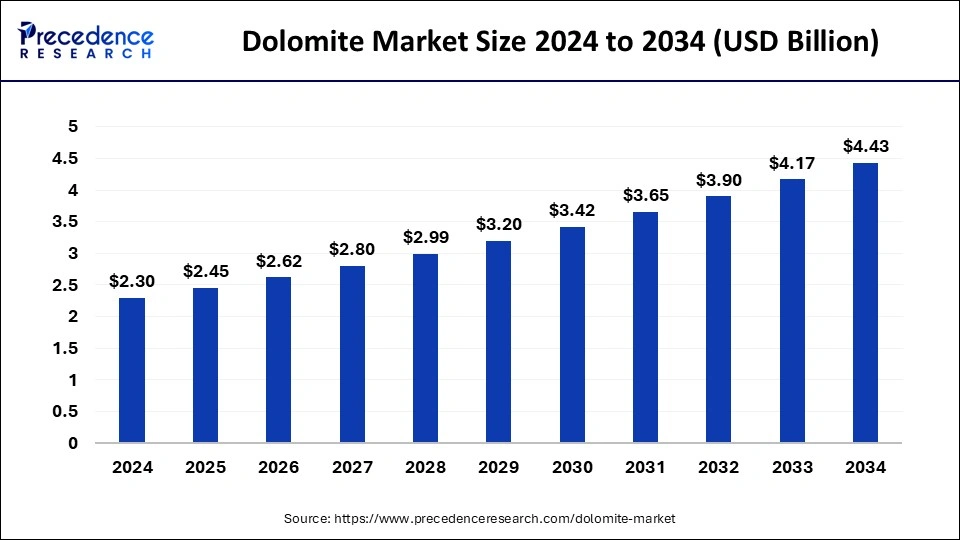
The Asia Pacific dolomite market size surpassed USD 850 million in 2024 and is projected to attain around USD 1,660 million by 2034, poised to grow at a CAGR of 6.92% from 2025 to 2034.
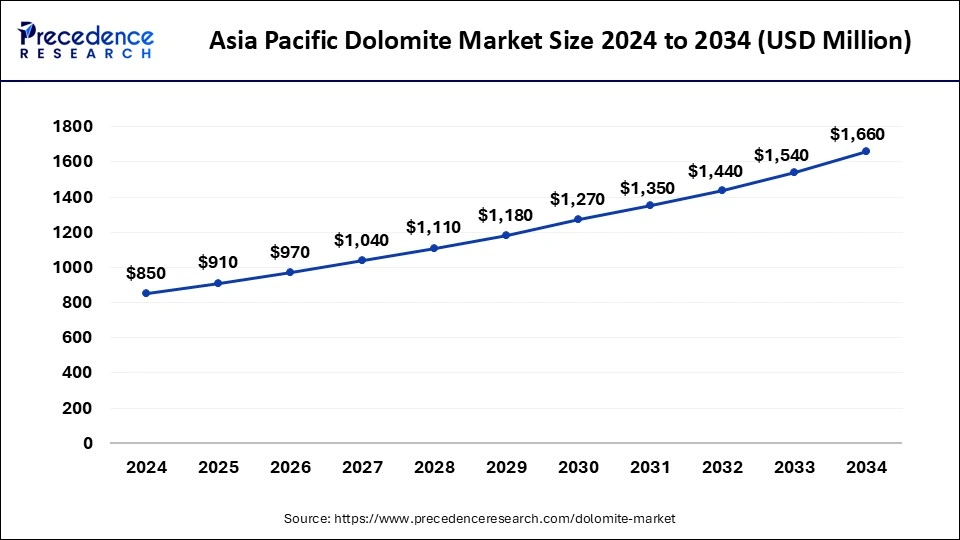
Asia Pacific led in 2024 and is observed to sustain the dominance during the forecast period. The building and asphalt industries are the main users of dolomite as an aggregate and building material. The demand for dolomite was driven by the expansion of infrastructure projects in nations like China, India, and Southeast Asia.
In agriculture, dolomite is applied as a soil conditioner to deliver nutrients and balance acidic soils. In certain areas, measures to improve soil quality and agricultural practices increased demand for dolomite. There are a number of domestic and foreign competitors in the Asia Pacific dolomite market. Market trends can be influenced by supply chain dynamics, pricing, and geopolitical considerations.
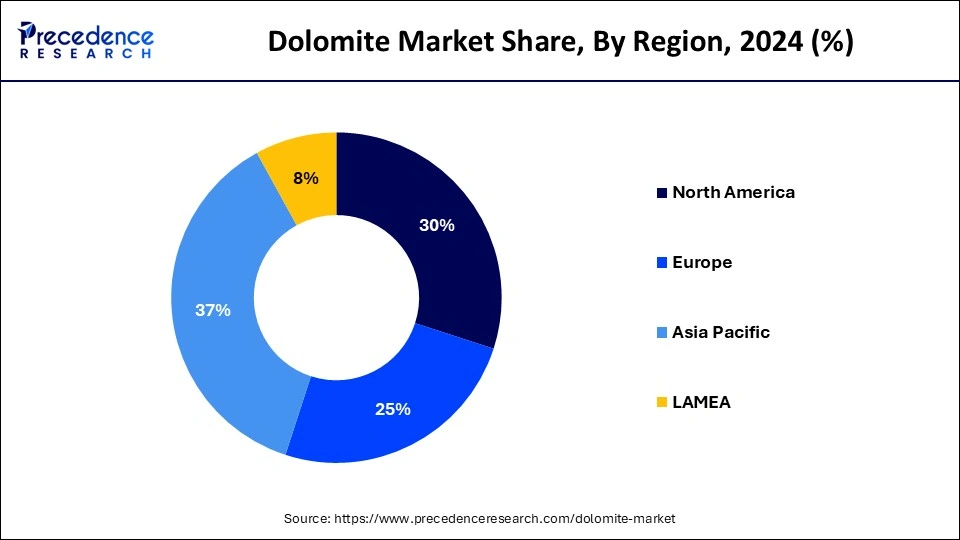
North America is expected to grow at the fastest rate in the dolomite market during the forecast period. Several variables have impacted the North American dolomite market in recent years. Dolomite, a mineral consisting of calcium magnesium carbonate, has several industrial uses because of its durability, hardness, and special qualities. Dolomite is extensively utilized in a variety of industries, including steel, ceramics, glass, and agriculture. It is utilized as a magnesium source and to make fertilizers, magnesium salts, and other compounds.
Dolomite mining and its use have an impact on the environment. In particular, dust emissions, water quality, and land reclamation are factors to be aware of. The future of the market in North America is dependent on improvements in agricultural practices, infrastructure development, and economic expansion. Future trends in the dolomite market may be influenced by innovative dolomite applications and sustainable mining techniques.
The dolomite market refers to the market for the carbonate mineral dolomite, which is made up of calcium magnesium carbonate. The production, sale, and consumption of dolomite in a variety of industries and applications make up the market economically, including the dynamics of the world's supply and demand for dolomite.
Because of its unique physical and chemical characteristics, dolomite is widely used in a wide range of sectors, including water treatment, iron and steel, ceramics, and agriculture. The harmony between the world's dolomite output and its utilization in various industries. Among its many uses are as a refractory material, a source of magnesium oxide for a variety of industrial purposes, a flux in the manufacturing of iron and steel, a soil conditioner in agriculture, and a material for ceramics.
There are dolomite resources in many parts of the world, and Mexico, China, India, the United States, and other countries produce a sizable amount of the mineral. These include shifts in pricing, improvements in mining and processing technology, environmental issues surrounding the extraction of dolomite, and changes in regulations pertaining to its use.
| Report Coverage | Details |
| Market Size by 2034 | USD 4.43 Billion |
| Market Size in 2025 | USD 2.45 Billion |
| Growth Rate from 2025 to 2034 | CAGR of 6.77% |
| Largest Market | Asia Pacific |
| Base Year | 2024 |
| Forecast Period | 2025 to 2034 |
| Segments Covered | Product, End-use, and Regions |
| Regions Covered | North America, Europe, Asia-Pacific, Latin America, and Middle East & Africa |
Growing demand for construction
Dolomite is a raw material used in the production of cement and concrete. It is crucial for infrastructure projects because it gives building materials strength and longevity. In addition, dolomite is utilized in bitumen and asphalt mixtures, which aid in the building of roads and highways. These surfaces perform better and last longer because of their qualities. Dolomite is occasionally applied to soils as a soil conditioner to increase their pH balance and fertility. Construction tasks related to agriculture and landscaping are supported by this program. Dolomite is used as a fluxing agent in the steelmaking process to help remove impurities and guarantee the quality of the steel that is produced. This helps construction inadvertently by providing necessary building supplies.
Health and safety issues
Breathing in dust from dolomite deposits can cause respiratory issues such as asthma, coughing, and dyspnea. Depending on the amount of silica in the dust, prolonged exposure might result in diseases such as silicosis or pneumoconiosis (dust lung disease). Silica is frequently found in dolomite deposits and can be discharged into the atmosphere during mining and processing. Because it can lead to lung conditions like lung cancer, silicosis, and chronic obstructive pulmonary disease (COPD), silica dust is very dangerous. Risks associated with working at and near mining sites include tripping, falls, and injuries from falling objects or machinery. To reduce these dangers, appropriate safety procedures and personal protective equipment (PPE) are crucial.
Medical and pharmaceutical uses
Dolomite is a naturally occurring source of calcium and magnesium, two vital minerals. In order to treat deficits in these minerals and support bone health and neurological function, it is occasionally taken as a dietary supplement. Because magnesium is essential for the activity of enzymes, muscle contraction, and nerve transmission, it can be found in medicinal formulations made from dolomite. Because of its opacifying and absorbing qualities, dolomite is frequently utilized in cosmetic goods. Face powders, creams, and lotions contain it. Dolomite is helpful in the production of glass and ceramics because of its high melting point and hardness, which tangentially assists businesses that supply raw materials for pharmaceutical and medical equipment.
The calcined segment dominated the dolomite market in 2024. The phrase "calcined segment" usually designates a particular product category in which calcination is applied to dolomite. Calcination is the process of heating dolomite to a high temperature (often exceeding 800°C) to eliminate carbon dioxide, producing dolime, often referred to as calcined dolomite.
The process of heating dolomite to a high temperature releases carbon dioxide and yields calcium and magnesium oxide, which is then known as calcined dolomite. The steel industry, for example, has a significant impact on the demand for calcined dolomite due to its critical role in regulating slag chemistry and raising steel quality. Global demand exists for calcined dolomite, with substantial production and consumption occurring in areas with thriving magnesium and steel industries.
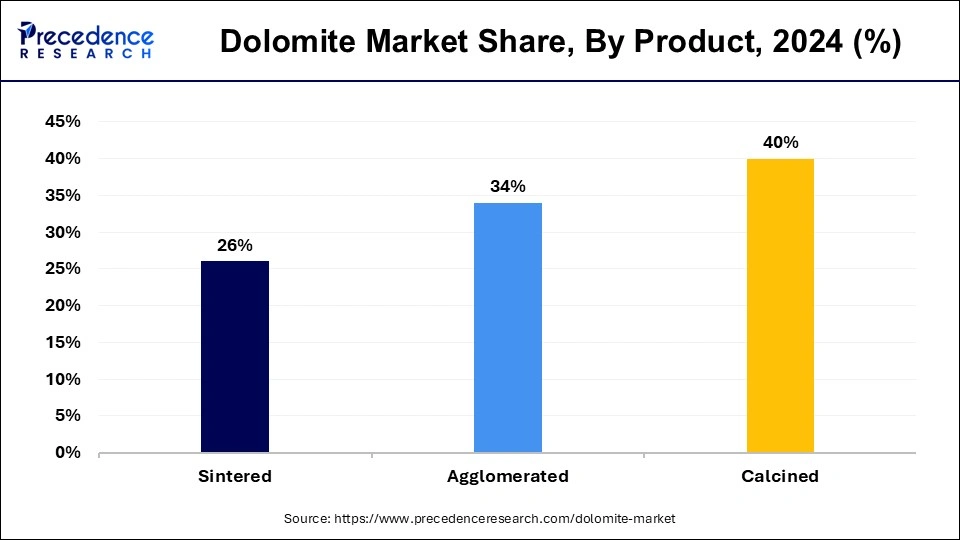
The sintered segment is expected to grow at the fastest rate in the dolomite market in the coming years. Segments of sintered dolomite are usually used to describe particular uses in sectors like steelmaking, where dolomite is employed because of its high magnesium concentration and resistance to high temperatures. These sections play a critical role in the manufacturing of refractory bricks and linings for high-temperature industrial operations such as steelmaking furnaces.
The expansion of building projects and infrastructure initiatives is also important. The production of cement and asphalt using dolomite has an indirect impact on the demand for products related to dolomite. Changes in product compositions and manufacturing techniques may have an effect on the dynamics of the sintered dolomite market. The price and accessibility of certain resources may change as a result of improved processing methods.
The iron & steel segment held the largest share of the dolomite market in 2024. Dolomite is largely consumed worldwide by the iron and steel industry. Because of its magnesium concentration and capacity to neutralize acidic impurities in the processes used to make iron and steel, dolomite, a mineral consisting of calcium magnesium carbonate, is widely used in the iron and steel industry. Dolomite is utilized in the desulfurization and deoxidation processes to produce iron and steel.
It enhances the quality and characteristics of the finished steel product by assisting in the removal of sulfur and oxygen from molten iron. Refractory bricks and linings for steelmaking furnaces and converters are made of dolomite. It is perfect for lining steelmaking vessels because of its high refractoriness, resistance to thermal stress, and exceptional resistance to slag corrosion.
The construction segment is expected to grow at the fastest rate in the dolomite market in the coming years. Because of the many qualities of dolomite that make it ideal for construction, the construction sector of the market is very important. Dolomite is a common component found in asphalt and concrete compositions. Because it is strong and resistant to weathering, it gives these materials strength and durability.
Dolomite is mined for use in construction, especially in the production of dimension stone blocks. These stones can be utilized for flooring, cladding, and other architectural purposes in building projects. In the production of cement, magnesium oxide (MgO) is obtained from dolomite. It influences the cement's chemical composition and may strengthen its defenses against outside pressures.
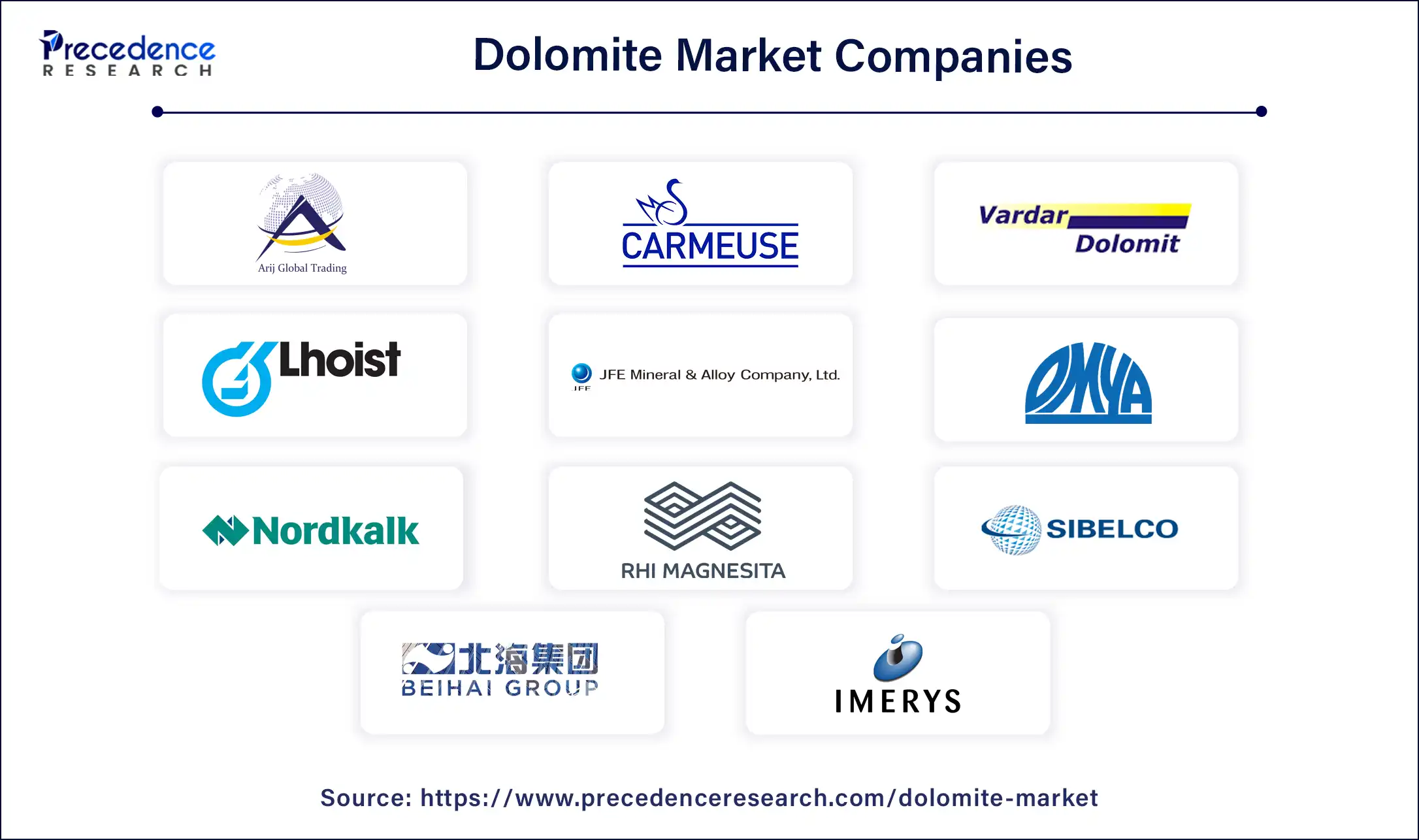
By Product
By End-use
By Geography
For inquiries regarding discounts, bulk purchases, or customization requests, please contact us at sales@precedenceresearch.com
No cookie-cutter, only authentic analysis – take the 1st step to become a Precedence Research client